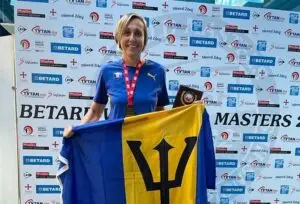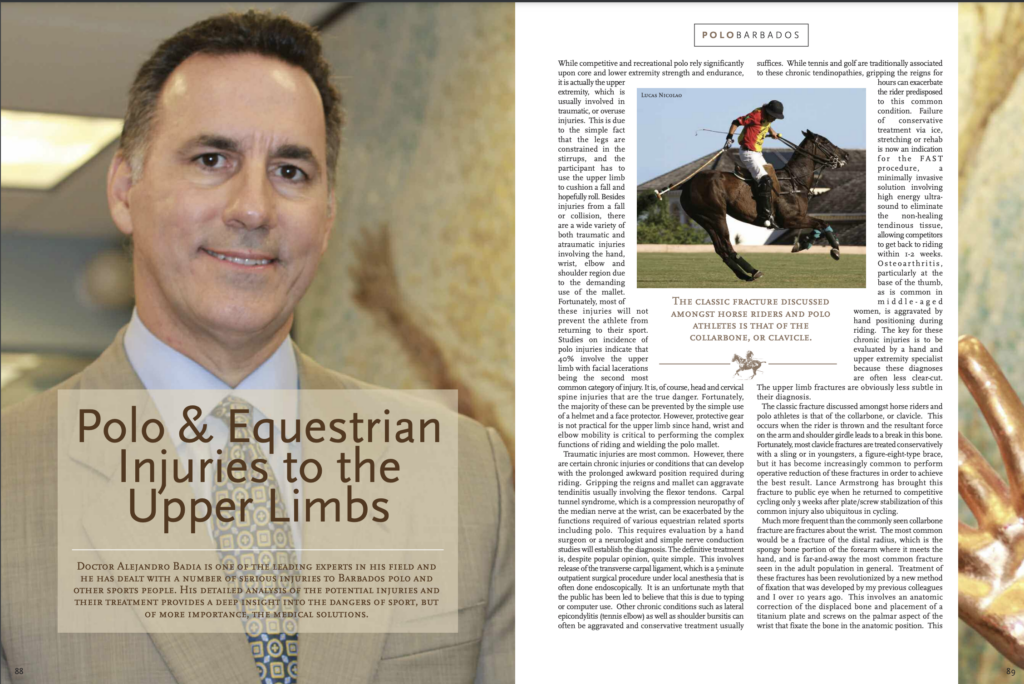

This article was first published on Polo Barbados 2014 Edition. You can read here testimonials from polo players such as Monique Archer and Danny Atwell. The article is still very relevant today not only for polo players but also for golf players and other competitive and recreational sports’ players. If you are suffering pain in your upper limbs, no matter the level of injury, please read on, and call our office. You are never late for a precise treatment that would maximize your return to full function.
While competitive and recreational polo rely significantly upon core and lower extremity strength and endurance, it is actually the upper extremity, which is usually involved in traumatic, or overuse injuries. This is due to the simple fact that the legs are constrained in the stirrups, and the participant has to use the upper limb to cushion a fall and hopefully roll.
Besides injuries from a fall or collision, there are a wide variety of both traumatic and atraumatic injuries involving the hand, wrist, elbow and shoulder region due to the demanding use of the mallet. Fortunately, most of these injuries will not prevent the athlete from returning to their sport. Studies on incidence of polo injuries indicate that 40% involve the upper limb with facial lacerations being the second most common category of injury. It is, of course, head and cervical spine injuries that are the true danger. Fortunately, the majority of these can be prevented by the simple use of a helmet and a face protector. However, protective gear is not practical for the upper limb since hand, wrist and elbow mobility is critical to performing the complex functions of riding and wielding the polo mallet.
Traumatic injuries are most common. However, there are certain chronic injuries or conditions that can develop with the prolonged awkward position required during riding. Gripping the reigns and mallet can aggravate tendinitis usually involving the flexor tendons. Carpal tunnel syndrome, which is a compression neuropathy of the median nerve at the wrist, can be exacerbated by the functions required of various equestrian related sports including polo. This requires evaluation by a hand surgeon or a neurologist and simple nerve conduction studieswill establish the diagnosis. The definitive treatment is, despite popular opinion, quite simple.
This involves release of the transverse carpal ligament,which is a 5-minute outpatient surgical procedure under local anesthesia that is often done endoscopically. It is an unfortunate myth that the public has been led to believe that this is due to typing or computer use. Other chronic conditions such as lateral epicondylitis (tennis elbow) as well as shoulder bursitis can often be aggravated and conservative treatment usually suffices. While tennis and golf are traditionally associated to these chronic tendinopathies, gripping the reigns for hours can exacerbate the rider predisposed to this common condition. Failure of conservative treatment via ice, stretching or rehab is now an indication for the FAST procedure, a minimally invasive solution involving high energy ultrasound to eliminate the non-healing tendinous tissue, allowing competitors to get back to riding within 1-2 weeks.
The key for these chronic injuries is to be evaluated by a hand and upper extremity specialist because these diagnoses are often less clear-cut. The upper limb fractures are obviously less subtle in their diagnosis. The classic fracture discussed amongst horse riders and polo athletes is that of the collarbone, or clavicle. This occurs when the rider is thrown and the resultant force on the armand shoulder girdle leads to a break in this bone. Fortunately,most clavicle fractures are treated conservatively with a sling or in youngsters, a figure-eight-type brace, but it has become increasingly common to perform operative reduction of these fractures in order to achieve the best result. Lance Armstrong has brought this fracture to public eye when he returned to competitive cycling only 3 weeks after plate/screw stabilization of this common injury also ubiquitous in cycling. Muchmore frequent than the commonly seen collarbone fracture are fractures about the wrist. Themost common would be a fracture of the distal radius, which is the spongy bone portion of the forearm where it meets the hand, and is far-and-away the most common fracture seen in the adult population in general. Treatment of these fractures has been revolutionized by a newmethod of fixation that was developed by my previous colleagues and I over 10 years ago.
This involves an anatomic correction of the displaced bone and placement of a titanium plate and screws on the palmar aspect of the wrist that fixate the bone in the anatomic position. This allows for rapid recovery of function with essentially no long-termdeficit. Riders can return to their sport within several months after this injury using this new technique. However, themost classic polo injury about the wrist is the dreaded scaphoid fracture that is now managed with a compression screw to allow early motion and avoid stiffness and atrophy from prolonged casting. Until recently, there was a high incidence of scaphoid nonunions where the fracture never heals and leads to chronic issues in the wrist that needs more aggressive reconstruction.
The current protocol of offering early percutaneous (tiny incision) screw fixation has minimized these complications and is preferable for the athlete who wants to get back in the saddle sooner. More subtle injuries to the wrist include ligament tears between the small carpal bones,which require an astute examination by a wrist specialist in order to establish a diagnosis. This is the most common cause of chronic wrist pain and is an entity that requires careful attention. The clinician should be experienced in wrist arthroscopy since this is the only sure way to establish the diagnosis, and can offer minimally invasive treatment.
The smaller bones in the hand can also be involved in trauma from a fall or an ill placed swing of the mallet, including phalangeal and metacarpal fractures, but these tend to be less common. Fortunately,major fractures occur only during high-speed falls or in older riders who may have osteoporosis. Complex fractures about the elbow can occur and there is a great variation in the fracture patterns. It is important that an upper extremity specialist evaluate these injuries, as recovery of full elbow range of motion is often difficult.
The key point is to seek evaluation by a dedicated upper extremity specialist. This implies that the rider be appropriately immobilized during the visit to the emergency room but then should seek the appropriate specialist on a less-emergent basis. The general orthopedic surgeon often addresses simple fractures, but the highly competitive polo competitor or horseman truly needs an optimal result in order tomaximize their return to full function. Given timely and precise treatment, there is no reason why a polo athlete or any equestrian sportsman should not be able to return to riding nomatter what the level of injury to the upper limb.

Monday- Friday: 8:30AM- 5:00 PM
Saturday- Sunday: Closed